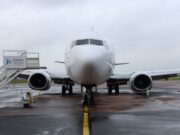
The Flight Safety Foundation has analyzed the past 16 years of aircraft accident data and found that the most common type of accident is the runway excursion, which accounts for 33 percent of all aircraft accidents.1 The highest risk factor for runway excursions is the unstable approach.2 Unstable approaches occur on 3.5 to 4.0 percent of all approaches, but only 3 percent of these unstable approaches result in a go-around being called in the cockpit: almost all aircrew in this state — 97 percent — continue to land. It can be argued, therefore, that the almost complete failure to call go-arounds as a preventive mitigation of the risk of continuing to fly approaches that are unstable constitutes the number one cause of runway excursions, and therefore of approach and landing accidents. If our go-around policies were effective even 50 percent of the time, the industry accident rate would be reduced 10 to 18 percent. There is no other single decision, or procedure, beyond calling the go-around according to SOPs that could have as significant an effect in reducing our accident rate. Why, then, is compliance so poor?
The Foundation in 2011 initiated a Go-around Decision Making and Execution Project designed to mitigate runway excursions caused by unstable approaches by achieving a high level of pilot compliance with go-around policies. This project expects enhanced compliance to result from answering the research question, “Why are go-around decisions, that should be made according to policy, actually not being made during so many unstable approaches?” and then making recommendations based on the findings. The project, which is ongoing, also will examine the psychosocial contributions behind flight operations management’s role in the phenomenon, as well as the risks associated with flying the go-around maneuver itself.
In a series of articles to be published in AeroSafety World over the course of this year, we will describe the latest results of the project’s work, which to date includes a worldwide pilot survey conducted on behalf of the Foundation by The Presage Group. The survey is designed to understand the psychology of decisions to go around rather than to continue to fly unstable approaches.
This first article describes a novel strategy for understanding this psychology, which we call the Dynamic Situational Awareness Model (DSAM), that we successfully have applied in several other operational contexts to help mitigate risk and increase compliance. The remaining articles will include the results of two experiments conducted within the pilot survey in which we assessed factors leading up to a decision. The experiments attempted to answer such questions as: “Are go-arounds associated more with some kinds of instabilities than with others?”; “What sorts of pilot characteristics, if any, are associated with go-around decision making?”; “What information did pilots solicit to assess risk prior to making their decisions?”; “What is the implicit incentive structure for flying go-arounds versus continuing the unstable approach that pilots perceive in their organization’s culture?”; “What is the nature of the crew interactions that support compliance with go-around policies?”; “In hindsight, to what factors do pilots attribute their decisions to go around or continue with an unstable approach, and do these reflect all the experiences that were actually inputs to their decisions?”; “What are the true key drivers of their risk assessments and decisions?”; “Do pilots experience any post-decisional regret for non-compliance with go-around decision making protocols?”; “Do pilots accept the basic definitions set by their organizations for what defines an unstable condition, as well as the standard operating procedures (SOPs) their organizations have set out to handle them?”; and “Apart from their company’s definitions, beyond what thresholds of instability on key flight parameters do pilots personally define themselves to be in an unstable state that warrants a go-around decision?”
By understanding more completely the answers to these questions, our goal is to bring new thinking to bear on the topic of non-compliance with unstable approach SOPs, and to offer ideas about how to mitigate these risks based on a better alignment of pilot psychology with company policy.
Dynamic Situational Awareness Model
Why is an investigation into situational awareness a valuable method for understanding a pilot’s decision making? Well, put very simply, prior to the pilots’ ability to accurately assess the operational landscape for potential threats and risks to aircraft stability, which would then shape their decision making around compliance, they must first and foremost be fully aware of the objective world around them.
In other words, the pilots’ very first psychological or cognitive act is being aware of their environment, in all of its facets, and it is this awareness that shapes and molds subsequent perceptions of operational risks and threats, and of the manageability of those risks and threats. These perceptions and judgments in turn inform decision making around risk appetite and compliance. From a psychological research point of view, it makes sense to test whether low situational awareness does in fact equate with poor risk assessments and increased rates of non-compliance during the unstable approach. In order to fully picture how DSAM is lived by pilots during an unstable approach, consider the following description.
Imagine, a pilot-in-command and his/her crew are flying a routine approach when they experience a late-developing instability below stable approach height (SAH; as defined by their company). How might we describe the psychology of this situation up to and including the moment when this pilot decides to go around or not, and the experiences of both the pilot flying and other crewmembers as they handle this rapidly changing situation under time pressure and heavy workload?
In the cognitive realm, what thoughts, beliefs, expectations and information factor into their situational appraisal of the instabilities and their manageability? By what cognitive calculus do they assess risks of both choices, continuing to land or going around? What other pre-cognitive, intuitive, emotional and implicit knowledge comes into play? And how does their immediate cockpit environment — the social realm, including the important contributions of crewmembers, of communications styles and of interpersonal dynamics — influence their decisions?
In Figure 1, we present the simplified sequence of events leading up to a decision between continuing an approach that is unstable in this scenario versus deciding to fly a go-around maneuver. Changing objective flight conditions and developing instabilities (step 1 in the sequence) must be noticed via the pilot’s senses, registered and mentally processed in light of their always-developing expectations about their current situation.
Situational awareness of the environment, in all its facets and continuous state of flux (step 2), is the psychological prerequisite state for a pilot to judge risk at any moment (step 3), and then to make a subsequent decision to maintain compliance and safety in light of that judgment (step 4). This state of awareness must be continuously updated and refreshed based on a stream of sensory inputs and knowledge provided by the pilots’ instruments, the kinesthetic and other senses, the crewmembers’ inputs and so forth.
This study employed DSAM for measuring and interpreting the psychological and social factors that collectively make up situational awareness. Within this model, situational awareness comprises nine distinct but interconnected and seamless sub-aspects of awareness (Figure 2). Much of the following discussion will be framed around how each of these sub-aspects influences a pilot’s risk assessment and decision-making processes, singly and in concert with one another, to remain compliant versus non-compliant in the face of aircraft instabilities while on approach.
In a typical response to the unstable approach event we have imagined, a typical situational awareness profile (SAP) emerges for the pilot flying the aircraft so as to maintain compliance with company SOPs. The “sequence” of processes might look something like the following. Imagine again our late-developing instability below SAH, and consider the pilots’ phenomenological experiences of it, as it is lived, through its description as an SAP. (Note: While we have serialized the subsequent description in steps to easily explain the various DSAM awareness concepts, these awarenesses actually exist in a mutually interdependent whole of causation, with rapid feedback loops and interactions. Changes to one type of awareness quickly influence the others in a psychological process called “spreading activation.”)
Example of a Go-Around Experience
- At a point immediately above SAH, the pilot’s “gut,” or what we refer to as affective awareness, subtly signals him or her to confirm that the aircraft’s flight characteristics and profile are normal. In a near-instantaneous and seamless fashion, this might be followed by …
- A visual check, or what we refer to as a check to provide functional awareness, which would be made where the pilot’s expert knowledge and ability to understand the instruments plays a key role in confirming whether the cue from their gut was, in fact, correct. Simultaneously, there is …
- An immediate and confirmatory statement from the pilot’s network of past experiences, or critical awareness, occurs, in which professional experience confirms the presence of a “normal” flight profile. Seconds later, however, imagine that in continuing its descent below SAH, the aircraft encounters significant turbulence with headwinds shifting to tailwinds and downdrafts altering VREF (reference landing speed) by +21 kt, accompanied by a vertical descent now greater than 1,100 fpm. Instantly, …
- The pilot’s anticipatory awareness, the ability to see these threats, registers in harmony with the reactivated gut, expert instrument knowledge and experience — all awarenesses that are now signaling a non-normal event — and there arises an immediate need for a signal from …
- Task-empirical awareness, the pilot’s expert knowledge of the safe operational envelope limits of the aircraft. Imagine further that this expert knowledge confirms that although the aircraft is now unstable, it still remains within the safe operational envelope. However, before concluding that parameters are now safe or unsafe, manageable or unmanageable, this developing event requires immediate input from another awareness competency …
- Compensatory awareness, or the ability to understand how to compensate correctly for non-normal events, occurs by referencing through functional awareness whether the aircraft and the instruments will direct the flight state back to a normal condition if acted upon. Whether the answer, not yet fully formed but informed by critical awareness, is likely to be “yes,” “no” or uncertain, imagine that the pilot is also simultaneously receiving …
- Through relational awareness — the pilots’ knowledge of how they use their relationships to protect safety — input from a crewmember that re-enlivens a memory trace of a prior verbal signal, based on a conversation and agreement earlier in the approach initiated by the pilot monitoring, that a go-around might be necessary should the aircraft become unstable at or below SAH, which …
- Informs and motivates the pilot to engage hierarchical awareness, or the individual’s expert knowledge of operational procedures under specific operational conditions, so as to confirm their ability to safely fly a go-around if necessary. Finally, with the pilot-in-command and other crew rapidly coming to a common assessment of, and agreement about, the risks inherent in continuing with the unstable situation that faces them, in comparison with the inherent risks of any go-around maneuver, and
- Confident that their company would support a decision to initiate a go-around, and in an expression of their environmental awareness concerning the wider organizational reward structures surrounding support for safety, the pilot flying puts all of these elements of awareness together to judge that the risks confronting the flight crew are not fully manageable, and so decides to call for a go-around.
Again, this description is not in any way intended to be prescriptive, that is, to suggest the way the dynamic situational awareness processes should work in this situation (i.e., the sequence or interactions among the awareness types). But it does illustrate that each of these awareness competencies needs to be used repeatedly and quickly to keep the entire spectrum of potential threats in the situation and their possible causes and resolutions alive in awareness at all times, and that there is a natural system of mutual causation among them that also must be sustained to maximize safe decision making.
Table 1 summarizes the complete system of nine DSAM concepts (called Construct 1 to Construct 9). The table shows a working name for each concept, its scientific name within our system and a brief definition.
What’s Ahead?
So far, we have summarized the problem and described the psychological theory behind our experimental survey framework. Robust experimental survey work, which we will describe in the next articles in this series, provides valid data and meaningful insight and understanding into this critical issue for flight safety, and from which we can begin to define necessary corrective actions.
In these articles, we will describe the results from analyzing data from more than 2,300 pilots asked to recall in detail the last instance in which they experienced an unstable approach that either led to a go-around decision or a decision to continue in the unstable state and land. In addition to reporting about various aspects of the DSAM model that differ between pilots going around and those continuing the unstable approach, we will also describe the kinds of objective flight conditions and pilot characteristics that are associated with these decisions, post-event perceptions pilots had about the causes of their decisions and hindsight judgments they made about the wisdom of their choices.
We will also describe the results of a second experiment conducted using the same survey, which was designed to investigate the personally held thresholds for instability that pilots believed would necessitate a go-around call, considering deviations in several flight parameters. Later articles will report on other aspects of the FSF project, including the results of the management survey on this topic conducted in parallel with the pilot survey, and a study of the risks inherent in the go-around itself.
Along the way, we will offer high-level observations and recommendations about the kinds of systemic mitigations that might be implemented to combat the various causes of pilot decisions not to go around while flying unstable approaches.
The Presage Group specializes in real-time predictive analytics with corrective actions to eliminate the behavioral threats of employees in aviation and other industries. Further details of the methodology of their survey, experiments and results are described at <www.presagegroup.com>.
Notes
- Flight Safety Foundation. “Reducing the Risk of Runway Excursions.” Runway Safety Initiative, May 2009.
- Burin, James M. “Year in Review.” In Proceedings of the Flight Safety Foundation International Air Safety Seminar. November 2011.


